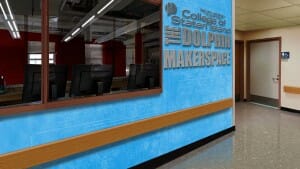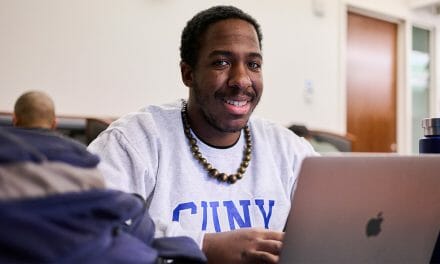
An artist's rendition of the CSI Maker Space & Innovation Suite, which will occupy the first floor of the Engineering Sciences building (4N).
A state-of-the-art MakerSpace & Innovation Suite will expand College of Staten Island students’ educational and experiential learning opportunities across several disciplines, thanks to $1.35 million in funding from the Staten Island Borough President’s Office and the New York City Council.
“I’m pleased to be able to allocate these taxpayer funds to create an experiential learning space for our students at the College of Staten Island,” said Staten Island Borough President James Oddo. “Bringing in new technology is an extremely beneficial tool for the success of our educational programs and students. I am grateful to see this Makerspace Lab being built so CSI can continue to give exceptional opportunities to its students.”
“After I visited the provisional lab these impressive students have been using to build their inventions, I felt strongly they deserved a space worthy of their ingenuity. These funds will help CSI build a state-of-the-art, innovation incubator, where their ideas can really come to life and help fuel the economy – right here on Staten Island,” said New York City Council Minority Leader Steven Matteo. “I am proud to have worked with Borough President Oddo and Speaker Johnson to provide the resources to make the “Dolphin Makerspace” a reality.”
“Ensuring that science and engineering students are getting a 21st century education means ensuring they have access to 21st century facilities. You can’t cut corners, especially when it comes to education and this new facility will give our students, the engineers and innovators of the future, a state-of-the-art place to explore and learn. The Council is proud to fund the state-of-the-art ‘MakerSpace’ at the College of Staten Island, and I would like to thank Minority Leader Matteo and Borough President Oddo for their partnership and support of this project,” said Speaker Corey Johnson.
The funds will be used to renovate the first floor of Building 4N, creating a suite of rooms that are equipped with the latest technology equipment and laboratory experimental setups.

The new CSI Maker Space & Innovation Suite will feature state-of-the-art equipment, including 3D printers.
“This is not going to be your typical maker-space that everybody is building these days,” said Prof. Neo Antoniades, chairman of the CSI Engineering & Environmental Science (EES) Department. “This is a combination – instruction-experimentation-innovation-simulation-prototyping – and so it’s about everything working together.”
Prof. Antoniades was referring to an interdisciplinary as well as a holistic approach that will involve a number of departments using the new space.
“Our vision is to create a highly inter-disciplinary space that will foster innovation, creativity and state-of-the-art instruction along with experiential learning among the students of many departments across campus,” said Kenichi Iwama, Vice President for Economic Development, Continuing Studies, and Government Relations. Iwama is the Principal Investigator on the project.
“We’ll be combining the lecturing part of education with experiential learning,” Prof. Antoniades said. “Students will go and start building. You need to combine theory with actually building things.
“This is the way the world is moving. This is how we do it.”
The $1.35 million funding comes on the heels of two other grant awards – from the National Science Foundation (NSF) and The Boeing Company – to continue the EES department’s work on the use of Plastic Optical Fibers (POF) in the aviation environment.

The Boeing Company is using advanced components developed by College of Staten Island Engineering and Sciences professors.
A $450,000 NSF award will allow Profs. Dwight Richards, Xin (Jessica) Jiang, and Antoniades from CSI as well as Prof. Ioannis Roudas from Montana State University/Bozeman to continue their work on designing systems and networks for the airplane environment with the guidance of The Boeing Co. and an international collaboration with their longtime partners at the department of Electrical Engineering and Communications at the University of Zaragoza, Spain.
“GOALI: Collaborative Research: An Experimentally Validated Simulation Framework for Next-Generation Plastic Optical Fiber-based Systems on Airplanes” is a joint effort that will bring $350,000 to CSI while an additional $100,000 will go to the collaborating institution, the Montana State University at Bozeman.
At the same time, The Boeing Company is providing an additional $20,000 to continue a collaboration with the CSI engineering professors that dates back to 2008. During this time, CSI/CUNY is the only university that has worked with the commercial avionics division of the company to help with research in the use of POF on the airplane.
“We are so proud to find out that the Boeing 777-X which is considered the most advanced plane in the world and is being rolled out of the assembly line as we speak has an optical component that we helped design” Prof. Antoniades said.
While telecommunications companies use glass fiber optic cables to transfer tremendous information across land and oceans, those cables are not ideal for airplanes. Glass fibers are difficult to handle and install and their performance is susceptible to dust and vibrations.
As Kien Truong, a Boeing Company Technical fellow, recently discussed at the International Conference on Plastic Optical Fibers in Seattle in September, POF is a great solution because of its large core and ease of installation. In the past, commercial airplanes have used copper wires, but these also have significant drawbacks; copper is heavy and susceptible to interference in thunderstorms due to electromagnetic disruption.
“So, the plastic fiber optic cable is not only lighter, it’s safer,” Prof. Antoniades said.

















